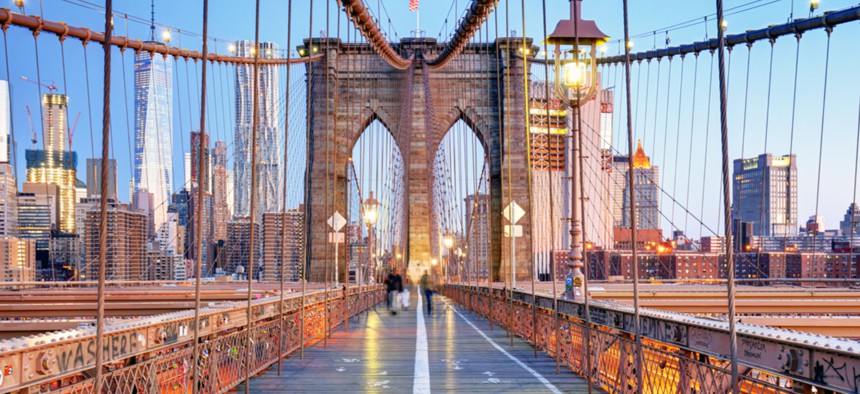Thousands of Bridges In 'Urgent Need of Repairs'

The Brooklyn Bridge is one of nearly 235,000 bridges requiring structural rehabilitation, repairs or replacement. Shutterstock
Twenty-three percent of Rhode Island's bridges are structurally deficient, while Iowa has 4,675 bridges in the state that should be rehabilitated, according to a new report.
More than 47,000 of America’s bridges are in urgent need of repairs, slightly fewer than last year thanks largely to the federal government’s new definition of the term “structurally deficient.”
The new classification requirements, approved by the Federal Highway Administration two years ago, focus on a narrower range of characteristics that no longer include “bridges where the overall structural evaluation was rated in poor or worse condition, or with insufficient waterway openings,” according to the 2019 bridge report, compiled by the American Road & Transportation Builders Association, or ARTBA.
Because of the change, “there are 6,533 bridges that would have been classified as structurally deficient in 2017, but did not meet the new criteria in 2018,” says the report, which is based on an analysis of the federal Department of Transportation’s National Bridge Inventory database.
Yet the number of structurally deficient bridges has dropped consistently in the last five years—and would have decreased under the original definition as well. According to the analysis, 47,052 bridges were considered in poor condition in 2018, down from 47,619 in 2017 and 52,905 in 2014.
Those classifications are updated continuously as inspections are conducted, so bridges are moved on and off the list of deficient structures “as they undergo repair, rehabilitation or replacement.” In 2018, a total of 5,660 bridges were newly classified as structurally deficient, while 6,229 moved off the list, for a total decline of 567 bridges—the smallest in five years.
“At the current pace, it would take more than 80 years to replace or repair the nation's structurally deficient bridges," Dr. Alison Premo Black, the ARTBA chief economist who conducted the analysis, said in a statement. “That's longer than the average life expectancy of a person living in the U.S.”
Structurally deficient bridges are not “imminently unsafe, but they are in need of attention,” according to the report. In addition to the 47,052 bridges considered in poor condition, an additional 69,000 are operating under weight limits or other protective measures designed to reduce stress on the structures.
In total, there are nearly 235,000 bridges across the country that need structural repair, rehabilitation or replacement, including the Brooklyn Bridge in New York City; Memorial Bridge between Washington D.C. and Arlington, Va.; and the San Mateo-Hayward Bridge across the San Francisco Bay. Completing all the necessary repairs would cost nearly $171 billion, according to the ARTBA.
Rhode Island has the greatest percentage of structurally deficient bridges (23 percent of the state’s total inventory), followed by West Virginia (19.8 percent), Iowa (19.3 percent), South Dakota (16.7 percent) and Pennsylvania (16.5 percent). By sheer numbers, Iowa leads (4,675 bridges), followed by Pennsylvania (3,770), Oklahoma (2,540), Illinois (2,273) and Missouri (2,116).
About half of bridge repairs in the country are paid for using the federal Highway Trust Fund, which is paid for primarily through the federal gas tax, but has needed funding boosts in recent years to remain solvent. The fund is projected to run out of money by 2021 without additional revenues. The Trump Administration’s 2020 budget proposal would grant states and transit agencies the authority to tap into the fund but does not guarantee timely payment, which transit officials have said could lead to work delays. To that end, ARTBA President Dave Bauer urged federal officials to guarantee the fund’s solvency.
"The best way to 'bridge' the infrastructure investment gap is for Congress and Trump administration to provide a permanent revenue solution for the federal Highway Trust Fund,” he said in a statement.
Kate Elizabeth Queram is a Staff Correspondent for Route Fifty and is based in Washington, D.C.
NEXT STORY: Rail Travel Is Cleaner Than Driving or Flying, but Will Americans Buy In?





